Young scientists sample the freshwater food chain through GM's Ride the Waves at Michigan Tech's Great Lakes Research Center.
Whitefish bellies, lard-filled olives—and a boat ride on Michigan Tech's 36-foot Research Vessel Agassiz. Just the thing to hook elementary students on science, technology, engineering and math.
Funded by General Motors (GM) since 2013, Ride the Waves gets about 700 students per year out on local waters and into GLRC labs to work side-by-side with Michigan Tech students, staff and faculty. The goal: to better understand the freshwater environment and factors that affect it, from phytoplankton to mining waste.
Students board the R/V Agassiz in groups of 15, half remaining in the lab with Ride the Waves instructors—Michigan Tech students—to guide them through lab investigations, while the students aboard collect surface-to-bottom lake samples (every layer tells a story).
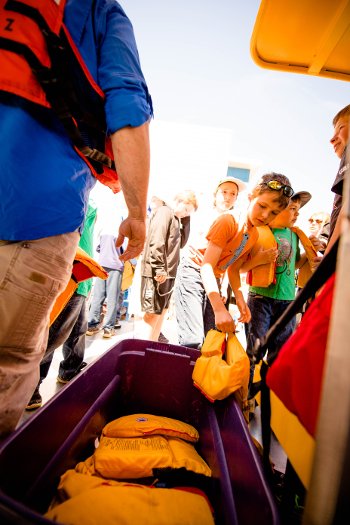
Welcome Aboard: Safety First
"This is a work vessel. My job is to keep everybody safe," explains R/V Agassiz Captain Stephen Roblee. Everyone less than 90 pounds gets a life jacket. No one argues, because he and Chief Scientist Brian Doughty are also wearing jackets—a rule for anyone working on the boat.
Captain Roblee notes that anyone who is working at the side of the boat, taking samples later on, also has to don a personal floatation device—and shows everyone where they are. For now, though, the rule is simple: sit down, away from the sides of the boat while she is pulling out of the dock. That way nobody loses their fingers.
Backpacks are passed hand-to-hand into the cabin interior, down into the space called the hold. Students are curious about everything. Captain Roblee explains there's a bathroom down there, too, "but it's not fun to use."
The Agassiz moves undaunted through the light chop of navy-blue waters on the Keweenaw Waterway. It's the sunny kind of Copper Country almost-summer day that makes you forget winter exists. Past the east end of campus, the boat slows briefly so Doughty, environmental science educator and field trip coordinator with the Center for Science and Environmental Outreach, can explain the tasks students will perform.
"Students constantly surprise me with what they know; they are incredibly smart! For me the most fun activity on the boat is pulling up the mud from the bottom and letting the students help agitate and catch all of the benthic critters that we look at back in the lab."
The Captain gradually throttles up to 8-knot cruising speed. The Agassiz's bow cuts through the water. We slow near the mouth of the Pilgrim River, where the waters are brownish. It's time to talk sediment, and deploy the Secchi disk.
Learning Nautical Research Lingo
Doughty and Roblee explain that special commands are used on working boats to keep people and vessels safe, for example, to make sure that the rope attached to the Secchi disk doesn't wrap around the engine propeller—that'll stop a boat dead in the water.
The Secchi disk, a simple and effective way to gauge water clarity, has been around since 1865, when the Italian Jesuit priest it is named for came up with a way to measure depths in the Mediterranean Sea. As Captain Roblee explains, it was a method to prevent ships from running aground in shallow water. Today it's used to gauge turbidity, by discovering how far down we can see into the water. The density of phytoplankton, including a myriad of algae forms: brown, green, dinoflagellates, and so on, dictates water color, along with bottom sediments and what washes out from shores, streams and other tributaries.
"Over the side!" Students pay out the disc, which is attached to a weighted line marked black on the half-meter, red on the full.
"In sight!" Students call out as soon as they can see the disk coming up from the bottom, eight meters down. They calculate and record the data, and Doughty leads a spirited discussion about why turbidity is important because it alters light in aquatic systems, affecting photosynthesis and oxygen levels, along with the type and number of organisms that can live in the water.
Roy Aho watches the fun with a quiet smile. He accompanied grandson Eli Wanhala, who is going into fourth grade at Hancock Elementary this fall. Ride the Waves offers experiences for early elementary to high schoolers. "It's wonderful for kids of all ages," says Aho, who taught biology in Upper Michigan's Mid-Peninsula School District.
"I want to catch the plankton." Eli has his working life jacket on and heads for the net, which he fittingly describes as a giant tea bag.
"We're all gonna get plankton."
It's also an apt metaphor for the tannin that colors the waters: "a little like making tea with the trees," notes Doughty.
But no one would want to drink the stuff that's collected from the lake. Doughty passes a yellowish-tinged jar of water around. Eliana Sommerville's face tells the story—this stuff smells mighty fishy, with an undercurrent of rotting vegetation. The home-schooled fourth-grader wrinkles her nose. Her pal, sixth-grader Evelyn Austin of Copper Country Christian School, forgoes the sniff test in favor of the lilac bouquet she picked that morning.
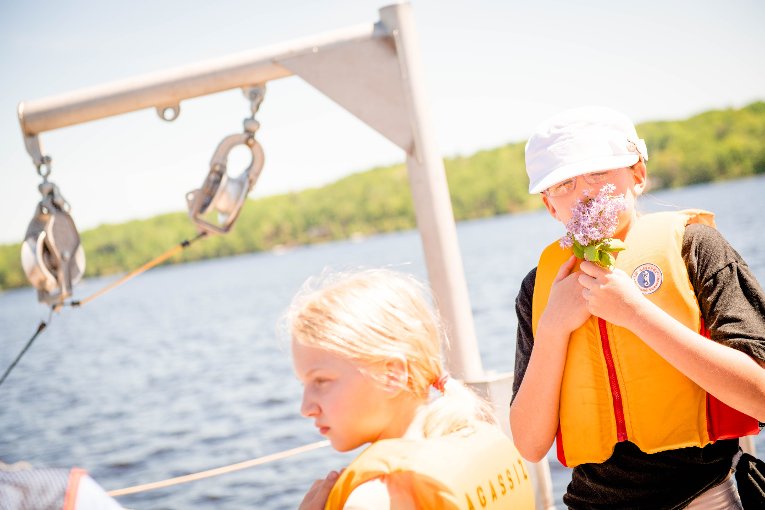
Meet the Benthic Community
The small organisms that live on the lake bottom, among aquatic plants, in cracks and crannies of rocks, logs and man-made habitat have much to tell us about environmental health. Benthic macroinvertebrates are, essentially, "the critters you find in the mud," explains Doughty. A PONAR grab sampler, composed of two semicircular opposing jaws is attached to a winch line; and lowered to take a rectangular bite out of the bottom.
"Over the side!"
"In sight!"
What Evelyn describes as "grainish chocolate pudding" is deposited in a collection box, where students get their first look at what's in it. Then the rectangular hunk of glop is dumped into the critter-catching sink at the back of the boat.
Some organisms are big enough to see without a microscope. Doughty points out a bloodworm, one of Portage Lake's most common inhabitants, and not really a worm at all. Bloodworms are midges in the larval stage. Deposited as eggs on the water surface, these non-biting, non-feeding members of the no-see-um family sink to the bottom to gestate, eventually returning to the surface for three-to-five day lives in which they're often spotted swarming around outdoor lights.
With all that mud on hand, Doughty suggests it might be fun to paint your face, like athletes wearing eyeblack, or a spa facial, although he admits "I put it on my head and it didn't make my hair grow back." Everyone laughs, and a couple of students take him up on the suggestion.
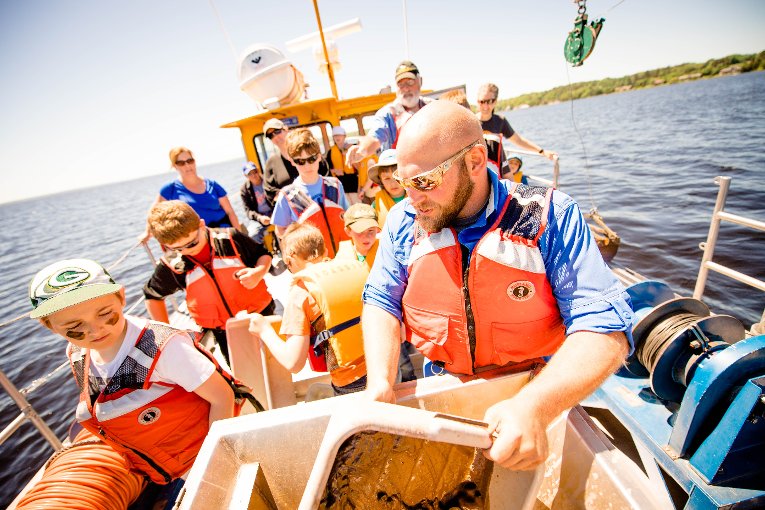
Back at the waterfront research center, students observe the squiggling zooplankton (you can remember the term means animals because it's called "zoo," instructor Abi Raetz explains). The third-year environmental engineering student lets students guess, with the help of a diagram, the identity of the largest spherical creature, with six protruding pincer-like tentacles, pulsating on the microscope's projection screen. Hands shoot up enthusiastically, as they have all day. Eager students readily ask questions and share what they know.
Is it Daphnia? "It looks like a small Copepod to me," Raetz says, pointing out that the characteristics of body composition are better indicators than size.
Matthew Langlais, a fourth-year environmental engineering major, mans the controls at the phytoplankton magnification station. Third-year environmental engineering student Elizabeth Sundblad is in charge of the Crisco, olives—and whitefish stomach dissections, the latter of which explains the smell when we return to the lab, where the first wave of students already completed the activity.
Students gauge the right amount of lard to put in olives to suspend them in a water tank, replicating fish swim bladders.
"It was so fun to have an activity like this to tie into the lesson about food webs and feeding habits of fish. We found some worms, rocks, and a lot of sand in the stomachs. The kids loved it!"
Speaking of bottom feeders: whitefish stomachs are not the most enticing aroma in the world, but they certainly captivate student attention. “After they would get the olives to suspend, some would say, 'so that looks like my fish is a bottom feeder, so they would have a downturned mouth,' which is what I was teaching them about," Sundblad says.
Find out more about Michigan Tech's Ride the Waves programs for all ages: learn how to chart a nautical course, about remediating mine waste on Torch Lake, or explore the unusual concentration of shrimplike Diporeia in Lake Superior's Ring of Fire.
Michigan Technological University is an R1 public research university founded in 1885 in Houghton, and is home to nearly 7,500 students from more than 60 countries around the world. Consistently ranked among the best universities in the country for return on investment, Michigan's flagship technological university offers more than 185 undergraduate and graduate degree programs in science and technology, engineering, computing, forestry, business, health professions, humanities, mathematics, social sciences, and the arts. The rural campus is situated just miles from Lake Superior in Michigan's Upper Peninsula, offering year-round opportunities for outdoor adventure.
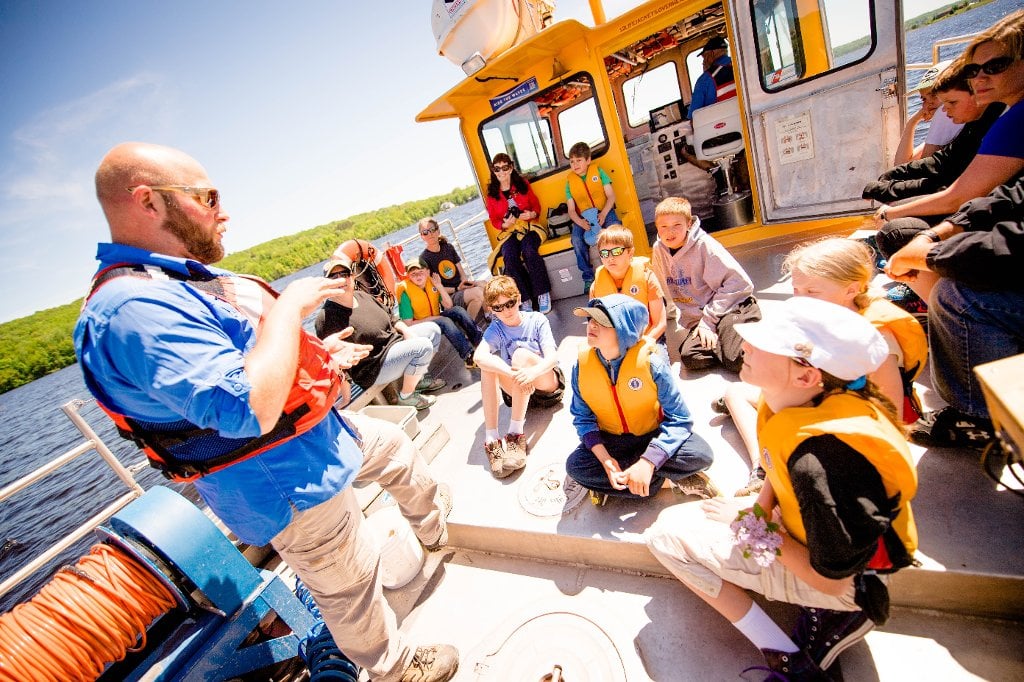

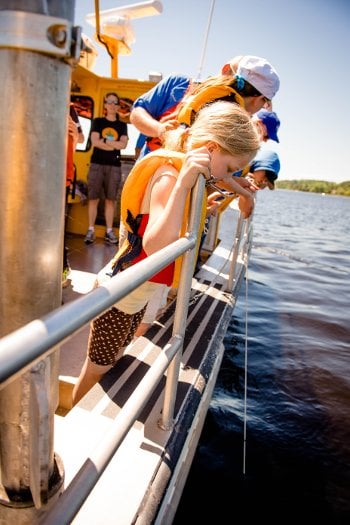

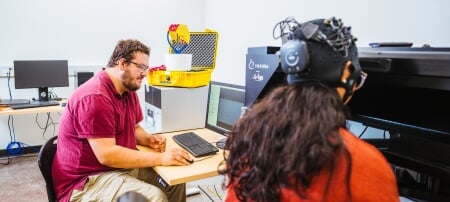


Comments